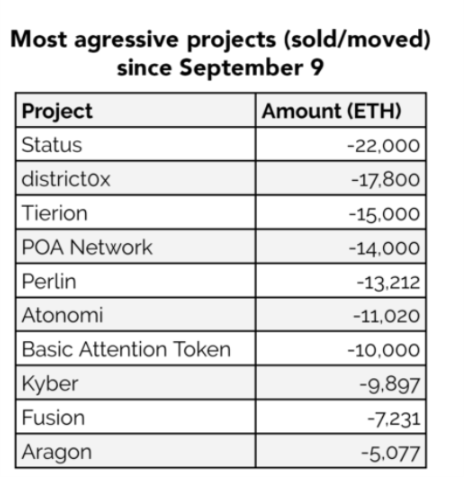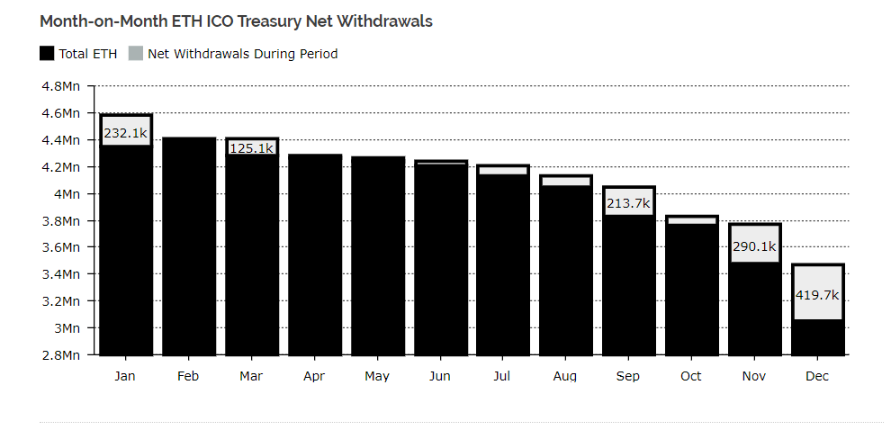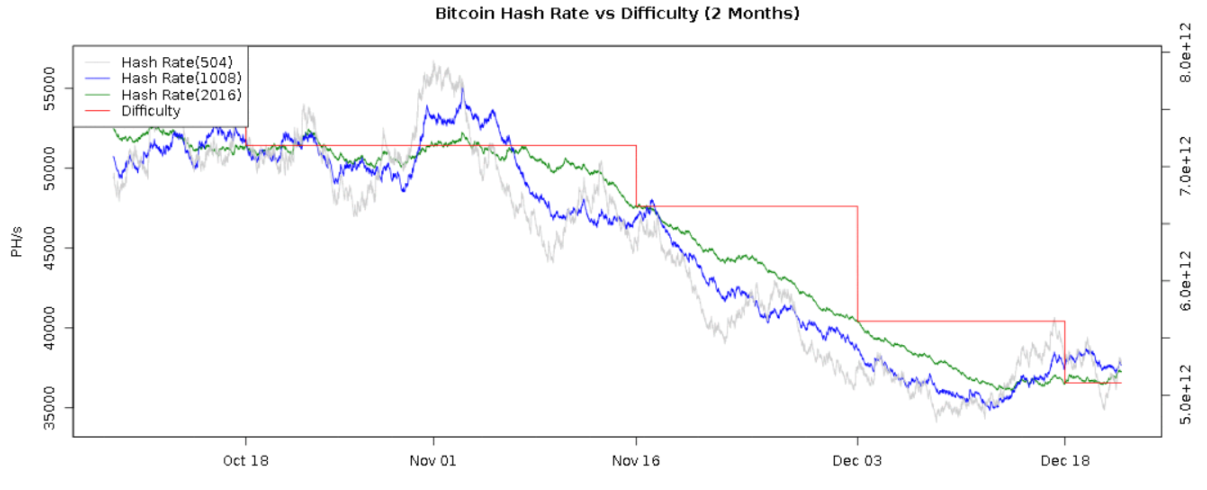While the Northern hemisphere is feeling the cold of winter, the cryptocurrency industry has been freezing for close to a year now. Crypto winter has taken its toll financially as well as emotionally, bringing down numerous projects, businesses, and investors.
This Great Filtration, as I like to refer to it, is separating the professionals from the amateurs, and though it hurts now I believe crypto winter will strengthen the industry as a whole in the long run.
Badly managed projects without working products or even feasible use cases for blockchain technology — as well as outright scams that the 2017 mania gave rise to — are being culled from the industry, which will lead to a much healthier market once crypto gets back on its feet.
We saw a Cambrian explosion of projects over the past 2 years, yet most cannot escape reality; as with natural selection, only the strong ones will survive.
In this article, I take a look at the effects of the financial downfall of the industry, showcasing how it has affected several projects and how it has forced many of the industry’s players to radically change their approach and strategy.
I believe these insights are highly valuable, as they can signal how projects can make it through the cold of the crypto winter.
Evaporating Runway Funds
The cryptocurrency industry is fueled by its own payments processors, mainly through the Bitcoin and Ethereum network.
Most ICOs raised their capital through these assets, which was great when prices were still on the rise, but a financial nightmare after the market went south. Bitcoin dropped roughly 80% while Ethereum dropped around 90%, and this has created ICO turmoil.
The vast majority of projects held their war chest in the received crypto assets, and have effectively lost most of their projects’ runway over the past year. On this page, you can find data regarding the amount of Ethereum raised and sold by ICOs through September.
According to this data, projects including Status, DigixDAO, Aragon, and Gnosis seem to have been severely impacted by the market’s downturn.

It may come as no surprise that some of these projects are also among the most aggressive sellers of the past months.

On the other hand, projects such as Civic, EOS, Augur, and Populous have already sold most of their Ethereum raised, allowing them to escape the effects of the asset’s steep drop in price.

Another report published by diar.co examined the sale of ETH to fuel the treasuries of Ethereum-based projects, and assessed that selling activity is hitting record numbers.

This graph perfectly illustrates how painful Ether’s crash has been to new projects. Even though the sale of Ether has been on the rise, the decrease in value of these sales is staggering.
“What was once worth $3 billion is now worth only $350 million.”
This means that projects are selling more Ether and receiving less fiat in return, which explains the dark cloud still hanging above these projects and the price of Ethereum.
This is because most of these projects are still sitting on big Ether stacks, and they will have to fund their operations, forcing them to sell into the market at some point. It can be expected that these projects will try to maximize their runway by waiting for the price to rise, only to sell and as a result put downward pressure on the price again.
On another note, this research (from September 9, 2018) shows that most ICOs that raised capital in Ethereum have sold almost as much as the amount they raised in USD terms.
This, however, does not say anything about the future need of funding runways of these projects. Given that most projects still hold substantial amounts of Ethereum — and a lot of projects haven’t cashed out yet — this indicates that they still have a runway, for now.
They will likely only sell their Ethereum out of desperation, which is not a comforting thought.
All research displayed above is limited in scope, as not all projects are equally transparent about their Ethereum holdings and most are generally reticent about other crypto asset holdings, such as Bitcoin.
The Effects on Major Industry Players
The negative effects of the market’s downturn are shown by a wide variety of projects.
As most protocols and dapps do not generate any income, they are almost solely dependent on their runway. Since this value has drastically decreased, drastic measures have followed.
ConsenSys, the organization set to expand and develop the Ethereum ecosystem and blockchain infrastructure, has recently informed its employees that it will reorganize, as the current structure has become unsustainable.
ConsenSys is reportedly laying off 60% of its staff to make the transition to Consensys 2.0.
Decentralized social media platform Steemit has announced they are taking similar measures, and are in the process of letting 70% of their staff go. The reason for this, according to founder Ned Scott, was their acting on flawed financial assumptions based on the wrongly projected crypto bottom.
Ethereum Classic’s development team ETCDEV has been hit even harder by crypto winter, and they informed the Ethereum Classic community that they will shut down with the following message:
Unfortunately ETCDEV cannot continue to work in the current situation and has to announce shutdown of our current activities pic.twitter.com/N6xWnpBNJJ
— ETCDEV (@etcdev) December 3, 2018
As expected, the outlook for the investment side of crypto looks equally gloomy.
Most notable is the news of perma-bull Mike Novigratz’s Galaxy Digital investment firm reporting a loss of $136 million in the first 3 quarters of 2018.
However, Novogratz indicated that even though this loss is painful, Galaxy Digital isn’t going anywhere. He remains bullish on Bitcoin, several other major cryptocurrencies, and the prospects of cryptocurrency as a whole.
Some Projects Are Able To Hibernate
Even though all this financial gloom is to be expected after a year like 2018, it doesn’t make it any easier to swallow. However, there are several projects that managed to take shelter from the storm one way or the other.
Block.one, the company behind EOS, had already sold its Ethereum funding after the completion of their immensely successful ICO, during which it managed to attract roughly $4 billion.
Most of these funds have gone directly into stable fiat currency, and have provided the organization with an immense runway fund to develop the EOS ecosystem. EOS has established its Venture Capital arm, named EOSVC, and has reserved $1 billion for the development of EOS projects.
Both investment initiatives have been unaffected by the bears.
Dash, another top 10 player by market cap, is also financially sustainable, as indicated by CEO Ryan Taylor. As elaborated in a recent blog post, the organization behind Dash converted most of its funding directly into USD, which has provided the project with solid financials.
In a recent tweet, Lisk co-founder and CEO Max Kordek elaborated on the financial status of the protocol project and set out the financial strategy of Lisk HQ going into 2019.
He mentioned that they want to find an ideal balance between stable (Swiss Franc) and volatile financial assets (cryptocurrencies), and added that the Lisk Foundation will keep 3,000 Bitcoin and 7 million Lisk in their treasury.
Today, we've begun implementing our new financial strategy for the #Lisk Foundation. Watch the most recent #LiskNow to hear @MaxKordek explain our plans for the future. pic.twitter.com/NBUTpG0nqc
— Lisk (@LiskHQ) December 18, 2018
It can be expected that there are many more projects with healthy financials, based on their having converted ICO funding into stable financial assets and/or capitalizing on the price surge in late 2017.
Ripple, Tron, Stellar, Cardano, and IOTA are expected to be in good financial health, among others.
The Mining Industry
The plunging price of Bitcoin and other currencies has also strongly affected mining profitability.
Some MSM-touted “experts” have even been suggesting an inevitable mining death spiral in which the difficulty rate doesn’t drop fast enough relative to price, thus making mining so unprofitable that everyone drops out.
While this is theoretically possible, it seems rather unlikely, as this implies that all miners have been mining with only short-term profits in mind, invested in expensive hardware because of this, and have no long-term perspective whatsoever.
Exactly because of the difficulty adjustment mechanism, mining Bitcoin could even become feasible for the little guys again.

The difficulty adjustment is based on the total computing power of the network, and a decrease in it means that miners are turning off their hardware.
While the decreasing difficulty of mining is relatively good news for the little guys in the mining industry, big mining companies are making substantial losses that could lead to insolvency.
The most prevalent example of this is mining hardware manufacturer and mining stronghold Bitmain.
The company is looking into launching their IPO through the Hong Kong stock exchange — however, concerns are being raised over the most profitable company in crypto thus far.
This is because of 3 factors: the sharp decline in hardware sales, the dropping value of crypto assets, and the continuous decrease in mining profitability.
According to TechCrunch, Bitmain made a loss of $400 million in Q2 2018. And if rumors prove to be true, the Chinese tech giant lost another $740 million in Q3, and that’s excluding the cost of the Bitcoin Cash hash war.
Don’t Lose Hope…
While crypto spring might still be months (at least!) away, and all this all looks rather grim and unsettling, there is still light at the end of the tunnel.
The increasing legal attention paid to blockchain and crypto is giving every indication that crypto is here to stay, and the general consensus remains that blockchain and crypto will have a firm place in the future.
We just haven’t figured out what this looks like yet.
As the SEC is taking decisive action to bring down those projects that aren’t legally compliant, they are simultaneously manufacturing legal frameworks in which crypto assets could fit.
Bitcoin and Ethereum have already been given the green light in terms of legality, and Bakkt and ETFs are all set to launch in 2019.
The Bitcoin narrative is latching on, and more and more people are slowly starting to understand why a decentralized, supply-capped, censorship-resistant, immutable, and fully global digital financial asset makes sense.
Even though the current Bitcoin price may say the contrary, I assure you that Bitcoin isn’t going anywhere for the foreseeable future.
There are still plenty of financially healthy projects experimenting and developing their crypto assets and underlying protocols and networks.
A technology so powerful, yet so unexplored, takes time to develop. People tend to overestimate a technology’s impact in the short run, but severely underestimate its impact over the long term.
There is a strong negative correlation between developments and investments. As such, 2018 was the year of crashing prices, while on the backend of the industry, “BUIDL” has been the rallying cry. Blockchain and crypto infrastructure is strengthening by the week.
There are still 1.7 billion unbanked with no access to financial services, still billions of people victimized by authoritarian censorship. Fiat currencies are increasingly depreciating due to inflation. Centralized tech behemoths are still controlling and leveraging our most valuable asset — our data — without compensating us. Bankers and politicians are still as corrupt as they’ve ever been.
Even though crypto winter hasn’t been as catastrophic as, for example, the burst of the dot.com bubble around the year 2000, there are lessons to be learned.
The dot.com crash destroyed much value and many lives but out of the ashes, platforms such as Google, Facebook, and Amazon arose. These companies and their networks pushed on through and took advantage of the incredible promises of the, then largely unexplored, novel technology called the internet.
Where many new companies played into the hype of the internet and led investors to believe that they would be the ones ushering in the disruptions enabled by the World Wide Web, some unicorns actually followed through on their promises.
So will it happen again.
Crypto winter is making the industry much healthier, as it’s naturally getting rid of opportunism and amateurism, and paving the way for those visionaries that work extremely hard to make good on the promise that the technology holds.
They will still be around once the the snow starts melting and the true value that can be unlocked through blockchain technology starts blooming.
I will still be around to help pick up the pieces and build towards fulfillment of the ideologies that brought us into this industry in the first place. Will you?


